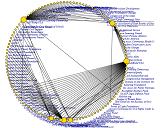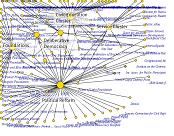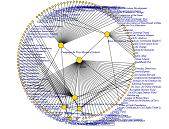« economic stimulus, compared | Main | trying to look at the Empire State Building »
October 25, 2010
a map of the civic renewal field
If there is not yet a civic renewal movement, there are certainly many organizations and individuals devoted to fair, deliberative, transparent, participatory democracy. If we hope to build a movement, it is important to understand these groups, how they fit together, and what types of organizations and coalitions may still be missing.
In 2005, I created two maps (one and two) using the links among civic organizations' websites to create a list of groups and then organize them as a network. That method is dependent on how webmasters handle links--always a bit arbitrary, and increasingly so as groups make heavier use of Facebook and Twitter.
So I have made a new map in a more-labor intensive way. I hand-entered information about all the member organizations of the following networks, which I would argue are important to the field:
- Strengthening Our Nation's Democracy II (a coalition of political reform, community organizing, and deliberative democracy organizations)
- Campaign for the Civic Mission of Schools (a coalition in support of civic education, which was not heavily represented at SOND II)
- Deliberative Democracy Consortium (a coalition that did participate in SOND II, but some of whose members did not)
- PACE--Philanthropy for Active Civic Engagement (ditto, but consisting only of foundations)
- The Democracy Imperative (ditto, but emphasizing higher education)
- The Voices for National Service Steering Committee (one of several networks in the "service" field).
I could have included other coalitions, such as the National Coalition for Dialogue and Deliberation, Service Nation, or the America's Promise Alliance, but each of these has such long lists of members that the total number of groups would have become enormous and, I think, less meaningful. By the way, I excluded individuals, government agencies, and whole universities, although I included specialized centers within higher education.
The result was a list of 117 organizations. I can think of missing groups, but the point is not to identify the organizations that I happen to know and admire, but rather to generate a network from a set of initial nodes that I don't control.
The resulting network has many links--for instance, my own center has close working ties with at least a dozen others--but to detect all the actual connections would be a major project. Instead, I simply entered memberships in the six coalitions listed above. That yielded 270 links. Click on the thumbnail to see the resulting network displayed as a set of rough clusters:
(The method I used here was to display all the nodes randomly on a blank plane within the free software package called SocNetV, and then apply an algorithm that treats each node as an electron that repels the others, and each link as a tie that pulls its two nodes together. That tends to sort the field into clusters.)
Here is another way to look at the map. Now the network hubs are placed close to the center in proportion to how many nodes they have. This is useful for showing which nodes are most important for keeping large sets of organizations connected. (The size of the node shows the number of members it has.)
And here is a third way. Now all the nodes are displayed around one circle. If every one were directly connected to every other, the picture would like like a tight ball of yarn. The white space in the middle indicates that the network is not very dense.

Maps are only one way to investigate this set of 117 organizations. One could also count what they do, how they are organized, and who runs them. I have not yet done that rigorously, but eyeballing the list reveals some clear patterns. Overall, I would make these observations:
1. We badly need an active and robust organization that fits in the spot occupied by SOND. If you deleted SOND from the network, its density would drop by 34%. The network is reasonably coherent if groups can communicate through SOND and be coordinated or convened by SOND. But SOND has no staff or budget. Thus the network is less robust than it looks, although the very existence of SOND lets us see the potential value of an organization in its spot.
2. We need more organizations with grassroots constituencies. The map includes some. For example, the American Federation of Teachers (AFT) is included because of its membership in the Campaign for the Civic Mission of Schools. But I would say there is a rough inverse proportion between centrality in this network and size of grassroots base. With a few exceptions, such as the League of Women Voters, the organizations that have the most citizen members are peripheral to civic renewal, and the pure civic renewal groups are grant-supported professional organizations or foundations.
3. We need more diverse leadership. I would roughly estimate that at least 90% of the top leaders of these 117 organizations are white and have college degrees.
4. Certain organizations play significant bridging roles, not as coalitions but as active members of multiple coalitions. The Kettering Foundation has four memberships within this network; Everyday Democracy and CIRCLE have three. Several organizations belong to two coalitions.
5. There is a reasonably broad ideological mix in the network as a whole. A simple left-right spectrum seems crude for understanding how these groups differ, but it is interesting that the network includes both ACORN and Teach for America (for example). Without taking a position on the issues that divide these two organizations, I would classify both as having a strategy for "civic renewal"--but each has a very different strategy.
October 25, 2010 9:18 AM | category: none
Comments
nonePost a comment
Thanks for signing in, . Now you can comment. (sign out)
(If you haven't left a comment here before, you may need to be approved by the site owner before your comment will appear. Until then, it won't appear on the entry. Thanks for waiting.)
